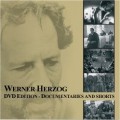| Reviews & Columns |
|
Reviews DVD TV on DVD Blu-ray 4K UHD International DVDs In Theaters Reviews by Studio Video Games Features Collector Series DVDs Easter Egg Database Interviews DVD Talk Radio Feature Articles Columns Anime Talk DVD Savant Horror DVDs The M.O.D. Squad Art House HD Talk Silent DVD
|
DVD Talk Forum |
|
|
| Resources |
|
DVD Price Search Customer Service #'s RCE Info Links |
|
Columns
|
|
|
Werner Herzog - Documentaries and Shorts
The distinction between documentary and fiction often feels arbitrary, but rarely more so than when applied to the films of Werner Herzog. His documentaries are frequently no less staged than his fictions. For example, the surrealistic Fata Morgana and Lessons of Darkness are influenced deeply by Herzog's wonder at what extra-terrestrials would make of mankind and its environment. Herzog's loathing of cinéma vérité as an overly simplistic method is apparent in his documentary works which are anything but objectively-direct, unmediated reality.
Herzog's obsessiveness on display in Erwin Keusch and Christian Weisenborn's Herzog biography I Am My Films (1978) is frequently evidenced in his documentaries. For example, in La Soufriere, as the populace of the Caribbean island of Guadeloupe evacuates in the face of an imminent volcanic eruption, Herzog risks the lives of his crew and himself by racing toward the volcano. Furthermore, obsessives are as frequently the subjects of Herzog's documentaries as they are of his fictions. From charismatic evangelical preachers (Huie's Sermon and God's Angry Man), to a self-proclaimed, reincarnated Christ (Bells from the Deep), to a mountain climber that continues to set climbing records even after the climbing-related deaths of his brother and many of his peers (The Dark Glow of the Mountains), to a ski jumper that repeatedly jumps beyond the bounds of safety (The Great Ecstasy of Woodcarver Steiner), to a man who wants nothing more than to be recognized as the world's best cattle auctioneer (How Much Wood Would a Woodchuck Chuck).
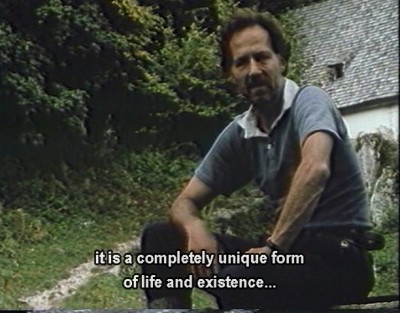
As Herzog declares in I Am My Films and Portrait Werner Herzog, if you want to understand who he is, watch his films. Werner Herzog - Documentaries and Shorts provides an extended opportunity to do just that.
Disc 1
Herakles (10 min., 16mm, b/w, 1.33:1, mono, 1962) (German audio with optional English subtitles). Made when he was 20, this is Herzog's first film. Herakles is a silent film with jazz score and occasional subtitles accompanying satirical juxtapositions of bodybuilders, car crashes, and American military might.
Last Words (Letzte Worte, 13 min., 35mm, b/w, 1.33:1, mono, 1967*) (Greek audio with optional German or English subtitles). Shot on the islands of Crete and Spinalonga, this experimental short uses non-actors and real locations to tell a surrealist tale of the last man to be evacuated from Spinalonga. The cinematography and the traditional Greek music is excellent.
The Unprecedented Defense of the Fortress Deutschkreutz (Die Beispiellose Verteidigung der Festung Deutschkreuz, 15 min, 16mm, b/w, 1.33:1, mono, 1966*) (German audio with optional English subtitles). A silently-shot short with added voiceover, The Unprecedented Defence of the Fortress Deutschkreutz is a satirical critique of militarism.
Huie's Sermon (Huie's Predigt, 42 min., 16mm, color, 1.33:1, mono, 1980) (English audio with optional German subtitles). Huie's Sermon documents a lengthy sermon delivered by a charismatic evangelical African-American preacher to his Brooklyn congregation. With the exception of some shots grounding the film in a Brooklyn slum, the film consists solely of a fervently delivered sermon. The Blues Brothers' Reverend Cleophus James (James Brown) has his real-world doppelganger here.
The Flying Doctors of East Africa (Die Fliegenden Ärzte von Ostafrika, 44 min., 35mm, color, 1.33:1, mono, 1969) (German or English audio with optional Italian subtitles). This documentary about an NGO physicians group operating in remote areas of East Africa focuses on the work undertaken and the cultural resistance encountered. Examples of cultural resistance to western medical practices include children shunned by their parents after prolonged stays in hospitals, patients with belly wounds dying after being fed by their families against doctors' orders; and, cancer sufferers deposited in the wild for hyenas to feast upon.
Wings of Hope (Julianes Sturz in den Dschungel, 66 min., 16 mm, color, 1.33:1, stereo, 1999*) (English audio). In 1971, a commercial jet airplane crashed in the Peruvian jungle. Twelve days after the crash, 17-year-old Julian Koepeke, the sole survivor emerged alone from the jungle. In 1999, Herzog accompanies Koepeke back to the wreckage of the crash. Herzog feels especially close to this story because he had been scheduled to fly on this overbooked flight in conjunction with his filming of Aguirre: The Wrath of God (Aguirre, der Zorn Gottes, 1972).
Precautions Against Fanatics (Massnahmen gegen Fanatiker, 12 min., 35mm, color, 1.33:1, mono, 1969) (German audio with optional English subtitles). A one-note mockumentary short about protecting racehorses from fanatics.
Disc 2
Land of Silence and Darkness (Land des Schweigens und der Dunkelheit, 82 min., 16mm, color, 1.33:1, mono, 1971) (German audio with optional English subtitles). A fascinating documentary, but a bit long, about Fini Straubinger, a deaf and blind social worker who ministers to the needs of others who are similarly afflicted by encouraging them to learn a tactual sign language. Straubinger and other participants take great joy in flying in a small airplane and visiting a cactus garden and petting zoo. The impact of this film on Herzog's later biopic The Enigma of Kaspar Hauser (Jeder für sich und Gott gegen alle, 1974) is readily apparent.
Handicapped Future (Behinderte Zukunft?, 43 min., 16mm, color, 1.33:1, mono, 1971) (German audio with optional English or Italian subtitles). A fairly conventional documentary intended to raise awareness about prejudices and other challenges faced by disabled people, especially children, in West Germany. The United States is portrayed as significantly more accommodating and less prejudiced than West Germany. During the making of this documentary, Herzog met Fini Straubringer whom he thereafter featured in the better known and more remarkable Land of Silence and Darkness detailed above.
Fata Morgana (74 min., 35mm, color, 1.33:1, mono, 1970*) (German or English audio). As the title implies, Fata Morgana is a study in mirages. This quintessentially Herzogian documentary begins with a test of the viewers' patience seemingly intended to separate the wheat from the chaff. For three and a half minutes, images of planes landing are shown from a fixed location without interruption or explanation. The eight plane landings have nothing to do with the rest of the film, except for the fact that the airplanes are reflected off the atmosphere near the tarmac as the planes land. Once past this opening prologue, the film contains three acts all set in and around the Sahara Desert: Creation, Paradise, and the Golden Age. In each act, images of the desert, its people and its mirages are shown accompanied by a disparate narrative and soundtrack. The techniques undertaken in this film of presenting the desert and its people as other worldly are brought to fruition in Lessons of Darkness.
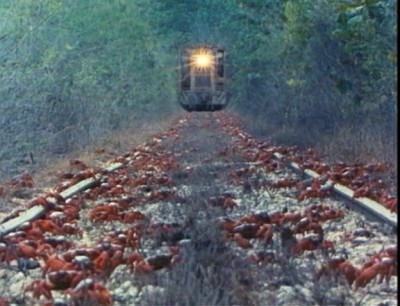
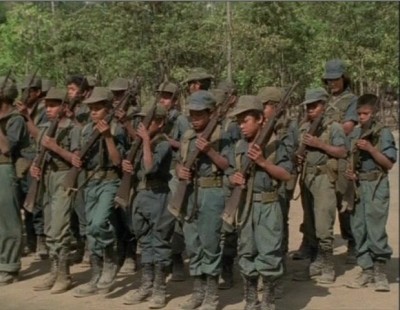
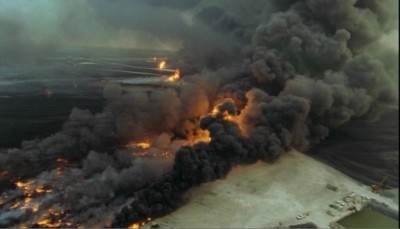
Disc 3
God's Angry Man (Glaube und Währung - Dr. Gene Scott, Fernsehprediger, 44 min., 16mm, color, 1.33:1, mono, 1980) (German audio with optional English or Italian subtitles). Dr. Gene Scott, an American evangelical preacher, appears live on television up to ten hours a night cajoling his viewers to call in with pledges of financial support. Only partially mollified on nights when he brings in $250,000, he swings between stony silence and angry tirades on nights when pledges are few and far between.
Echoes from a Sombre Empire (Echos aus einem düsteren Reich, 87 min., 16mm, color, 1.33:1, mono, 1990) (French audio with optional German or English subtitles). French journalist Michael Goldsmith returns to the Central African Republic, where under the autocratic rule of Jean-Bédel Bokassa, Goldsmith was tortured, presumably falsely, as a spy. Bokassa came to power in a coup d'état in 1966 and ruled until he was overthrown in 1979. After living in exile in France, Bokassa voluntarily returned to the Central African Republic in 1986 and was given a death sentence (pardoned in 1993). During his reign, Bokassa married more than a dozen women and fathered more than 50 children. He also brutally tortured or murdered his perceived enemies including at least two sons-in-law, and was widely purported to be a cannibal. Goldsmith interviews some of Bokassa's family and victims, and revisits the place where he was personally tortured by Bokassa.
How Much Wood Would a Woodchuck Chuck (How much Wood would a Woodchuck chuck... - Beobachtungen zu einer neuen Sprache, 45 min., 16mm, color, 1.33:1, mono, 1976) (German or English audio). This short doc shot at the World Championship of Livestock Auctioneers displays a peculularly Herzogian obsession with the poetry of commerce. Herzog's direction suggests that he believes that there's much here that only meets the eye with repetition upon repetition.
Disc 4
La Soufriere (La Soufrière - Warten auf eine unausweichliche Katastrophe, 30 min., 16mm, color, 1.33:1, mono, 1977) (German or English audio with optional Italian subtitles). At his idiosyncratic best, Herzog and crew race to the Caribbean island of Guadeloupe to document the imminent eruption of the island's volcano. At the time of Herzog's arrival, all but three of the island's 70,000 residents have evacuated. Herzog interviews the holdouts and approaches as close to the volcano as possible. The extent of the danger is made clear when Herzog recounts the fate of nearby Martinique whose 30,000 inhabitants were killed within seconds along with all hands aboard a Canadian rescue ship in the harbor when the island's volcano erupted with explosive force in 1902. Contrary to the expectation of everyone, Guadeloupe did not suffer Martinique's fate. Herzog and crew were not killed, and the inhabitants eventually returned. Despite the lack of tragedy, La Soufriere is thoroughly engrossing.
I Am My Films (Was ich bin, sind meine Filme, 92 min., color, 1.33:1, mono, 1978) (German audio with optional English or Italian subtitles). Filmed during the making of Stroszek, this biography of Herzog by Erwin Keusch and Christian Weisenborn is the only film in this box set not directed by Herzog. Clips of Herzog's films are intercut with interviews with Herzog. He discusses his childhood, his fondness for travel and breaking into holiday homes, and his loathing of cinéma vérité and abstract discussions. He also touches upon his intense working relationship with actor Klaus Kinski which is addressed in far more detail in his later documentary My Best Fiend (Mein liebster Feind - Klaus Kinski, 1999).
Jag Mandir (Jag Mandir: Das exzentrische Privattheater des Maharadscha von Udaipur, 83 min., 16mm, color, 1.33:1, mono, 1991) (German audio with optional English subtitles). This film documents a massive festival of traditional dance, song, and art in Udaipur, India hosted by the Maharajah, a hereditary noble, for his son. Like the Maharajah's palaces built at sea level, the arts on display are links to the past, now threatened.
Disc 5
The Great Ecstasy of Woodcarver Steiner (Die Große Ekstase des Bildschnitzers Steiner, 46 min., 16mm, color, 1.33:1, mono, 1973*) (German audio with optional English or Italian subtitles). Swiss ski jumper Walter Steiner is the subject of this biographical documentary short narrated by Herzog. Steiner, a carpenter by trade, was among the elite of ski jumping when this documentary was made. Herzog captures him in best form earning gold at the 1972 Ski-flying World Championships in Planica, Yugoslavia. Steiner repeatedly soars beyond the extreme limit of the groomed landing area setting new world records while risking his life. Though not mentioned in this documentary, Herzog had himself been a serious ski-jumper only a few years earlier.
The Dark Glow of the Mountains (Gasherbrum - Der leuchtende Berg, 45 min., 16mm, color, 1.33:1, mono, 1984*) (German or English audio). In the summer of 1984, mountain climbers Reinhold Messner and Hans Kammerlander ascended the 11th and 13th highest peaks in the world, Gasherbrum I & II in the Himalayas, back to back alone and without resupply. Herzog's film crew accompanied the pair to their base camp and awaited their return. The documentary focuses on the inner motivations of Messner who continued to climb after the climbing deaths of many peers including his brother.
No One Will Play with Me (Mit mir will keiner spielen, 14 min., 16mm, color, 1.33:1, mono, 1976) (German audio with optional English subtitles). A touching short story about a young boy ostracized by his classmates, No One Will Play with Me feels far truer to a child's subjective experience than most fictions of its ilk. Herzog masterfully manipulates the viewer's sympathies while building anxiety, with the resolution in doubt till the last minute.
Ballad of the Little Soldier (Ballade vom kleinen Soldaten, 45 min., 16mm, color, 1.33:1, stereo, 1984) (German or English audio). Co-directed with Denis Reichle, Herzog narrates this documentary about boy soldiers, as young as nine-years-of-age, fighting with the Miskito Indian resistance against the Nicaraguan Sandinistas.
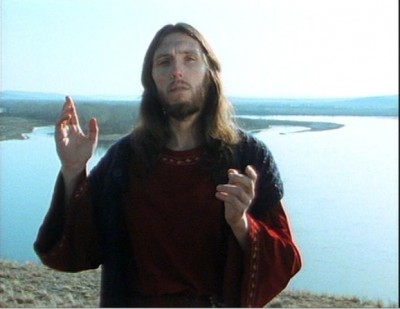
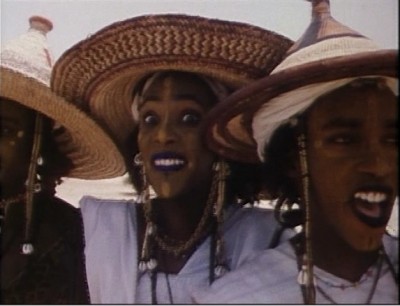
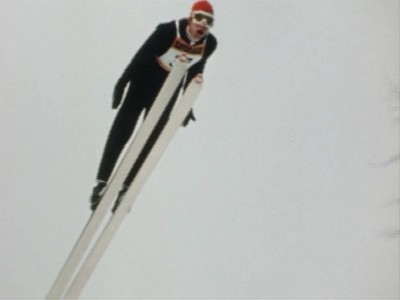
Disc 6
Wodaabe: Herdsmen of the Sun (Wodaabe - Die Hirten der Sonne. Nomaden am Südrand der Sahara, 49 min. 16mm, color, 1.33:1, mono, 1989) (German or English audio). Herzog narrates this documentary short which examines the Wodaabe, a nomadic tribe of herdsmen living along the southern edge of the Sahara Desert renowned for their physical beauty, and elaborate ceremonial attire. The film focuses on the annual Gerewol celebrations in which young women, regardless of marital status, freely choose sexual partners from among men dressed in finery and bright, distinctive makeup.
Lessons of Darkness (Lektionen in Finsternis, 55 min. Super16mm, color, 1.78:1 anamorphic, stereo, 1992) (German or English audio with optional English or Italian subtitles). A quintessentially Herzogian film, Lessons of Darkness begins with apocalyptic images of Kuwaiti oil well fires following the Gulf War, and ends with an enigmatic riddle of human behavior. Tucked in the middle is a compelling story of human ingenuity and professionalism. Herzog sparingly narrates with somber, elegiac words and tone. Music by Wagner, Verdi, Schubert, Mahler, Grieg, Gynt, and Mater is appropriate in tone, though perhaps too well known, and thus too grounding to be entirely satisfactory for this otherwise other-worldly vision.
Bells from the Deep (Glocken aus der Tiefe - Glaube und Aberglaube in Rußland, 60 min. Super16mm, color, 1.33:1, mono, 1993*) (German or English audio with optional Italian subtitles). A film about faith and superstition in Russia, Bells from the Deep features Russian Orthodox priests, an evangelical preacher, a shaman, a sorcerer/exorcist, and a self-anointed Jesus Christ reincarnate, along with all their various followers. Herzog refrains from offering personal comment, limiting his narration to direct translations of his Russian participants.
Portrait Werner Herzog (29 min., color, Super16mm, color, 1.33:1, mono, 1986) (German audio with optional English subtitles). In this self-portrait, Herzog discusses his childhood, his deep admiration for Lotte Eisner, the retired Chief Archivist for the French Cinematheque, his love of roaming, and his career as a filmmaker with special emphasis on his first feature film Signs of Life (Lebenszeichen, 1968), and on Fitzcarraldo (1982).
* Denotes that the year of completion provided by Werner Herzog Films varies from the year of release noted on IMDb.
The Presentation
Werner Herzog - Documentaries and Shorts includes six single-sided, dual-layered DVDs packed with 1125 minutes of material, in separate single-disc alpha cases, enclosed in a thin cardboard box.
Video:
The screen captures included in this review are representative of the quality of the films as a whole. The films included in this box set were originally shot on film, then digitized for PAL, and then converted to NTSC. Ghosting is evident but not distracting; the image is often soft; colors are frequently muted; and, many of the films evidence mild print damage. Nevertheless, this set generally looks better than I would have expected, and probably about as good as it can without an expensive restoration of the source materials.
Audio:
Ranging from mono to stereo, all the films in this set sound acceptable though none really shine. Dialogue is distinct and understandable throughout, and subtitles are fairly good with only infrequent, minor mistakes (e.g., the contraction it's where the possessive its is needed).
Extras:
There's nothing included beyond the films listed above.
Final Thoughts:
Werner Herzog - Documentaries and Shorts is an impressive collection of nearly 19 hours of Herzog's oeuvre. The steep list price of 150 Euros for this collection may be hard to justify especially for fans that have previously purchased the Region 1 DVD releases of Lessons of Darkness and Fata Morgana from Anchor Bay, and Land of Silence and Darkness, The Great Ecstasy of the Sculptor Steiner (aka, The Great Ecstasy of Woodcarver Steiner), How Much Wood Would a Woodchuck Chuck, and La Soufriere from New Yorker Video. For collectors that already have some of these films on DVD, or who otherwise only wish to acquire particular discs in this set, Werner Herzog Films also offers the six discs individually for 30 Euros each. The box set and individual discs may be purchased directly from wernerherzog.com.
For well-heeled and hardcore fans, Werner Herzog - Documentaries and Shorts is recommended.
|
| Popular Reviews |
| Sponsored Links |
|
|
| Sponsored Links |
|
|
| Release List | Reviews | Shop | Newsletter | Forum | DVD Giveaways | Blu-Ray | Advertise |
|
Copyright 2024 DVDTalk.com All Rights Reserved. Legal Info, Privacy Policy, Terms of Use,
Manage Preferences,
Your Privacy Choices | |||||||









